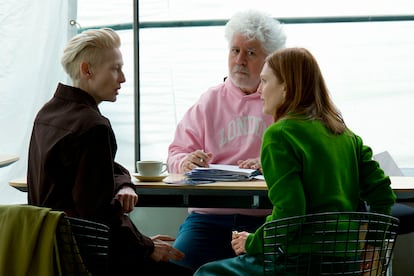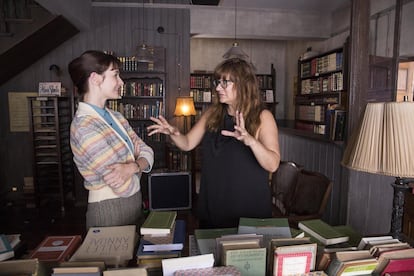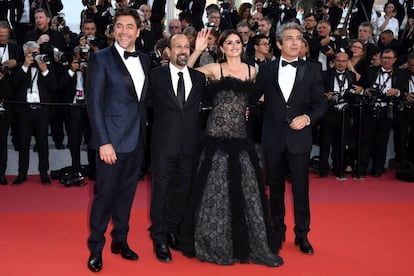From Asghar Farhadi to Pedro Almodóvar: The triumphs and failures of filming in another language
The release of ‘Haunted Heart’ and ‘The Room Next Door’ join a growing list of movies by filmmakers who have dared to try their hand at a foreign language

One person bought rice. Another bought a bottle of olive oil. Maybe someone picked up some biscuits. Nothing transcendental, nor particularly artistic. Just the usual stuff in a grocery store. However, while he helped his parents run their business, little Asghar Farhadi watched the customers and would daydream about their shopping carts, their looks or their characters.
“I imagined what life would be like in their homes. For me, it meant getting to know society. And that experience may have been what pushed me towards cinema,” the Oscar-winning Iranian director and screenwriter recalls.
It’s often said that God works in mysterious ways. So does the art of filmmaking.
It was difficult to foresee that the young boy would end up as a movie director. But, even more so, that one day he would film a movie, Everybody Knows (2018), almost 4,000 miles away from his native city of Khomeyni Shahr, in a language he didn’t speak.
Isabel Coixet’s destiny also seemed quite distant from life in Tokyo. Specifically, she had to travel almost 9,000 miles from Sant Adrià de Bèsos, in Spain’s Catalonia region, to narrate Map of the Sounds of Tokyo (2009) in the Japanese capital. Similarly, an ocean — and many worlds — separated the working-class Italian port city of Livorno from the historic U.S. Route 1 highway, where Paolo Virzì filmed The Leisure Seeker (2017).
Pedro Almodóvar, the iconic Spanish filmmaker, also made a massive leap from the small town of Calzada de Calatrava to the bustling New York City, where he filmed The Room Next Door (2024). His first English-language feature film will debut on September 2 at the Venice Film Festival and will hit theaters on October 18. The movie will show how the most famous director in Spanish cinema has solved a challenge that more and more creators and performers face on a hyper-globalized planet: filming in another language, while portraying a foreign country.

The challenge is intriguing, attracting many talented people. It can also provide wider marketing opportunities, as has been experienced by the English-language films of Luca Guadagnino, or those by directors specializing in horror and fantasy, such as the Frenchmen Alexandre Aja and Jean-François Richet, or the Spaniards Jaume Balagueró and Paco Plaza. In recent years, various filmmakers have sought to expand their stories into other territories, such as Juan Antonio Bayona and Alejandro Amenábar. At the same time, of course, such a transition can cause a certain amount of vertigo.
“But I like that, it forces you to leave your comfort zone and do your best,” says Spanish actress Aida Folch, whose English can be heard in theaters today thanks to the film Haunted Heart (2024), directed by Fernando Trueba. Clint Eastwood also successfully managed this risk in Letters from Iwo Jima (2006), recounting the clash between his country and Japan during World War II, from the Japanese perspective and language. Still, when he asked Paul Haggis to write the film, the screenwriter felt that he needed the collaboration of the Japanese-American author Iris Yamashita. The film ultimately received four Oscar nominations, including for Best Screenplay. But more importantly, the biggest recognition came from how successful the film was in Japanese cinemas.
This phenomenon fits into an era where everyone travels, tourism is on the rise and international couples multiply. Of course, critical magnifying glasses are also amplified: the natives of any country can’t wait to find fault with the foreign gaze. For instance, perhaps the least-celebrated film by the Japanese Hirokazu Koreeda in the last decade is The Truth (2019), shot in France in the local language, which he didn’t speak. To talk with Catherine Deneuve or Juliette Binoche on the set, he required an interpreter.

Virzì, the acclaimed narrator of the Italian soul, was showered with some of the harshest criticism of his career for the film that he set in the U.S. He was accused of offering a superficial vision of the country. Similarly, Woody Allen was reproached for doing this in Paris, Rome and Barcelona. To which he always replied that at no point in time did he intend to shoot a sociological treatise — he just wanted to make a film, from his perspective as a visitor.
“Language is important, but it’s not the first or the only element to relate [to something]. There are other elements within you [that are required] to understand others and for them to understand you. In the eyes, the body, the hands, perhaps you can capture something that you wouldn’t even guess from what someone is saying,” Farhadi reflects. “Sometimes, language can even be confusing: I was watching Tokyo Story (1953) with Japanese students. And a student asked me: ‘If what he’s saying at this moment isn’t so emotional, why does it impact [the viewer] so much?’”
Even so, it’s said that Dutchman Paul Verhoeven, a regular in American cinema, learned French before directing Isabelle Huppert in Elle (2016). And Almodóvar himself abandoned the adaptation of Lucia Berlin’s Manual for Cleaning Women (2015), telling Deadline: “I came to the decision that I’m not ready to tackle such a monumental project in English.”

Farhadi spent almost two years in Spain before shooting his feature film in the municipality of Torrelaguna, about 45 minutes from Madrid. He has also traveled frequently throughout Spain. And, for Everybody Knows (2018), he auditioned “practically all the actors in the country” and “learned all the dialogue phonetically,” as Álvaro Longoria, the producer of the film, recounted. Far from generating skepticism, the Iranian genius’ approach to Spain attracted the biggest stars of local cinema, resulting in a cast that included Javier Bardem, Penélope Cruz, Bárbara Lennie, Inma Cuesta and Eduard Fernández.
“Asghar [Farhadi] spoke in English with the actors with whom he could communicate in that language… but when he wanted to be more precise, he did so in Farsi. He really liked to comment on things about life, about Spain. He’s restless, he reads a lot and we talked about the script, but more about life in general. What I’ve learned from good directors, like Asghar, is that they’re very specific,” Fernández shares with EL PAÍS. With his talent, his own knowledge and the prominence of his actors, the filmmaker felt confident enough to venture into Spanish: he launched himself into filming a wedding, flamenco dancing, or townspeople gossiping.
Spanish director Isabel Coixet has never lacked guts, either. She switched to English for her second film, Things I Never Told You (1996). She’s had actors such as Ben Kingsley, Sarah Polley, Juliette Binoche and Gabriel Byrne under her command. And, in her films, Portuguese, German, Japanese and even Inuktikut have been spoken.
Coixet answers the phone from France, where she’s preparing her next series (in French). She tells EL PAÍS that, once again, she’s counting on a foreign catch: Tim Robbins. Afterwards, she’ll head to Rome, to adapt a novel by the late Michela Murgia for the screen… and, of course, she’ll do it in the original Italian.
“I’ve shot films in the languages that made sense,” she notes. “It’s always emerged in a natural way: the world is wide and foreign. I try to shed all my habits. [For example], if you order a potato omelette in Tokyo, you’re asking for trouble,” she laughs, alluding to the need to embrace new settings. “In any case, the mechanisms for making a film are, in some way, the same in Japan, Canada, Venezuela, Chad, or Uzbekistan. There’s a filming structure, no matter what language you speak,” Coixet adds.
However, in the field of acting, something does change, requiring more work. “In some way, there’s a barrier of understanding. I felt more emotionally distant. I was less precise in terms of intonations. The good thing is that it makes you more attentive [and] present. It’s more difficult to achieve authenticity. That’s why I do exhaustive prior work before arriving on the set,” says Aida Folch. The actress defines her English as “intermediate.” And that’s why, before the film, she rehearsed the script thoroughly with her tutor, Nieves Lázaro. So much so that, according to her confession, Trueba even feared that she had gone too far and her sentences would end up too “mechanical.”
Coixet, on the other hand, plans to ask an Italian friend for more informal lessons: to speak to her only in that language and refresh her memory before the next shoot. The filmmaker, while laughing, also recommends another method: “I’ve had boyfriends from several countries and that helps!”

“To play a role in another language, you have to understand it well enough to know the accents, the musicality, the intention of the word... and that takes time, a lot of time,” Eduard Fernández emphasizes. Especially for a leading role, as Penélope Cruz knows so well. Her efforts in Italian for the film Don’t Move (2004) saw her obtain the David di Donatello Award for Best Actress. Since then, the international star has returned to the same language in To Rome with Love (2012), L’immensità (2022), or Ferrari (2023). However, in this later film, directed by Michael Mann, she spoke in English with an Italian accent, resulting in criticism.
“She speaks with a Spanish accent trying to be [Emilia] Romagnola, like an exorcist with several voices inside her,” lamented the professional polemicist Luca Barbareschi. Cruz was similarly criticized for her performance in the film Loving Pablo (2017), the portrait of the Colombian drug lord Pablo Escobar filmed by Fernando León de Aranoa, with Cruz and Bardem operating in both English and Spanish.
Surely, in the history of cinema, many more films and languages have been discussed. After all, according to Ethnologue, there are 7,164 living languages. But for Folch, one more could be added: “I believe that there’s a kind of universal language in art. I’ve felt it when, for example, I worked on a German film and I understood the director perfectly. There was something there… an innate communication in knowing what you’re doing.”
Farhadi has a similar view: “There are people who, just by looking at their eyes, you can read many stories. Even ones that they’ve never told. That’s what attracts me the most.” It’s about looking at the eyes, be it on the outskirts of Tokyo, in a grocery store in Iran, or in the Spanish town of Torrelaguna.
Sign up for our weekly newsletter to get more English-language news coverage from EL PAÍS USA Edition
Tu suscripción se está usando en otro dispositivo
¿Quieres añadir otro usuario a tu suscripción?
Si continúas leyendo en este dispositivo, no se podrá leer en el otro.
FlechaTu suscripción se está usando en otro dispositivo y solo puedes acceder a EL PAÍS desde un dispositivo a la vez.
Si quieres compartir tu cuenta, cambia tu suscripción a la modalidad Premium, así podrás añadir otro usuario. Cada uno accederá con su propia cuenta de email, lo que os permitirá personalizar vuestra experiencia en EL PAÍS.
¿Tienes una suscripción de empresa? Accede aquí para contratar más cuentas.
En el caso de no saber quién está usando tu cuenta, te recomendamos cambiar tu contraseña aquí.
Si decides continuar compartiendo tu cuenta, este mensaje se mostrará en tu dispositivo y en el de la otra persona que está usando tu cuenta de forma indefinida, afectando a tu experiencia de lectura. Puedes consultar aquí los términos y condiciones de la suscripción digital.
More information
Archived In
Últimas noticias
ICE raids trigger school absenteeism and traumatize children: ‘They have been forced to leave their childhood behind’
Mexico’s missing people crisis casts a shadow over World Cup venue
Can cheese protect brain health? This is what the science says
Maude Apatow, from acting in ‘Euphoria’ to directing: ‘There are many films that you can tell weren’t written by someone young’
Most viewed
- Christian Louboutin: ‘Young people don’t want to be like their parents. And if their parents wear sneakers, they’re going to look for something else’
- US sanctions against jailed cartel leader ‘El Marro’ highlight Mexico’s lack of control over its prisons
- Cartels in Mexico take a leap forward with narco-drones: ‘It is criminal groups that are leading the innovation race’
- Liset Menéndez de la Prida, neuroscientist: ‘It’s not normal to constantly seek pleasure; it’s important to be bored, to be calm’
- ‘El Limones’ and the growing union disguise of Mexican organized crime











































